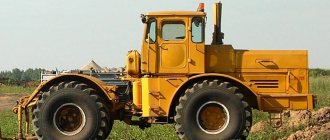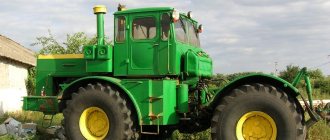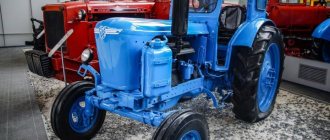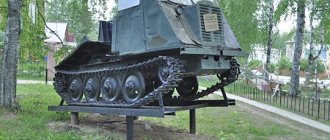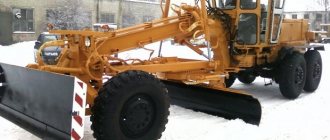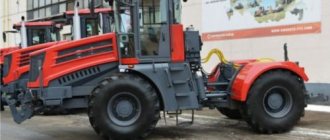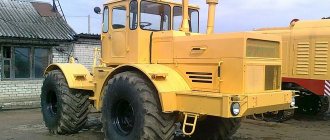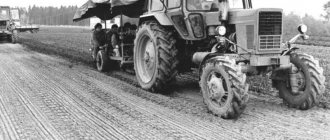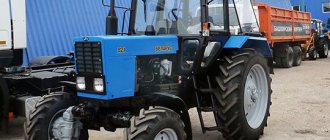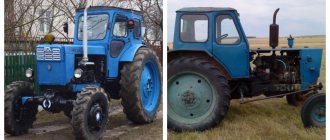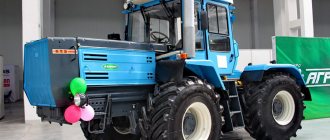In the early 1960s, the Soviet government set a task for agricultural workers: to bring the average annual grain harvest to 238-243 million tons. This was impossible without powerful tractors, and they immediately began to be produced. The Kirovets K-700 made a kind of revolution in large-scale farming, giving a powerful impetus to the development of this industry.
By the early 1990s, this powerful machine covered up to 40% of basic agricultural work. The K-700 was especially in demand in the grain-growing regions of Russia, Ukraine, and Kazakhstan. “Kirovets” also became famous for being the first Soviet tractor with rubber tires. Both our own experience and world practice said that such a tractor would be more convenient than a caterpillar tractor or one with metal wheels to move along highways at high speed under its own power, and would be easier to fit into the growing cargo flow.
Working in winter and summer, insensitive to Russian off-road conditions and quite comfortable, the Kirovets served for 20-30 years continuously on Soviet fields.
In the fall of 1959, N. S. Khrushchev, who was on a visit to the USA, was shown a powerful MV wheeled tractor from John Deere. The Head of the CPSU and the Soviet government not only appreciated it, but immediately upon his return, set the task of organizing production in the USSR on principle new energy-rich high-speed general purpose tractors with a capacity of 200-220 hp. with a wide train of mounted and trailed implements. Indeed, such cars were not produced in our country at that time, but they were needed.
Technical characteristics of Kirovets K-700
If we talk about the design of the Kirovets K-700, it corresponded to the technologies available at that time. In particular, the tractor was equipped with a 16-speed gearbox (four ranges) and a hydraulic turning system. Frame type: articulated. The transmission was installed mechanically, both axles were driven.
Thanks to its traction qualities (5 tons on the hook) and speed (the maximum value for plowing is 10 km/h), the tractor was significantly superior to the standard equipment of that time.
| Maximum operating speed | 10 km/h |
| Weight | 11,000 kg |
| Power | 220 hp |
History of creation
The history of the creation of the most legendary Soviet tractor is firmly associated with Nikita Khrushchev’s trip to America in 1959, when he visited the John Deere plant. In part, this is exactly so, but on the other hand, the USSR needed a sharp leap in agriculture and the creation of such machines was only a matter of time, and Khrushchev’s trip to America only accelerated this process.
In the 50s of the last century, the world gradually moved away from war and began another technical breakthrough. Agricultural machinery does not stand still, however, tractors of approximately the same class with an average power of 50-60 hp are being mass-produced all over the world; in the USSR these were DT-54 on caterpillar tracks. For those years, these were excellent machines, but at that time there were technologies that made it possible to create more powerful tractors. However, in the West, everything came down to money, because farmers never had a lot of money, but in the USSR everyone was happy with the DT-54, of which 50 thousand were produced every year and the state was more concerned about creating new tanks than tractors.
Since the beginning of the 50s, there have been attempts in the world to establish large-scale production of powerful tractors, for example, the Canadian company Wagner created machines with a power of up to 160 horsepower in the 50s. The gradual increase in demand for such tractors does not go unnoticed by large companies, and in 1959, a similar machine, the 8010 Goliaph, was created at the John Deere plant. It had a power of 215 horsepower, however, due to the rather high price, the demand for it was small, no matter how the company tried to promote its products, things did not go well. Only a few copies have been sold throughout history, but this particular car became the prototype for Kirovets.
Read Chelyuskin's epic
In 1959, Nikita Khrushchev arrived in America for a visit. In addition to establishing relations with America, the Soviet Secretary General was interested in American achievements in agriculture and mechanical engineering. And the Americans didn’t mind boasting about their successes, and it was also possible to try to sell something. One of the most important places to visit was the John Deere plant in Des Moines, where Khrushchev is shown exhibition copies. The Secretary General’s particular attention was drawn to the model 8010, which stood out among others for its power. Khrushchev took advertising booklets with him from the factory, which upon his arrival home he handed to the then Chairman of the State Committee of the USSR Council of Ministers for Defense Equipment K.N. Rudnev. After a meeting with representatives of the design bureau, the Kirov plant received the right to create such a tractor, the chief designer of which was then Zh.Ya. Kotin, who had previously headed the work on creating the IS and KV tanks and other famous Soviet developments of that time.
The task was not easy, and the plant understood that in order to quickly create a new tractor, it was necessary to buy a John Deere 8010. But while the decisions were making their way through the offices, relations with the United States had deteriorated, and there was no question of buying an American tractor; it simply would not have been sold . We started looking for something similar and after a long search in Sweden we managed to buy a brand new Canadian Wagner tractor, which, although slightly inferior to the American one, was created according to a similar design and generally met the specified parameters. The purchased tractor was disassembled down to its cogs, studied and began to create a similar machine.
Modifications
The second generation tractor, called K-701, was introduced in 1975. It received a more powerful engine (300 hp) and generally had higher performance parameters. In the same year, serial production of the K-700A with a 235-horsepower engine began. These models were unified among themselves, but at the same time they differed quite significantly from their predecessor. Difference: absence of springs; installation of two side fuel tanks instead of one rear; new wheels.
| K-700A | K-701 | |
| Structural weight | 11,900 kg | 12,400 kg |
| Engine | YaMZ-238ND2(ND3) | YaMZ-240BM2 |
| Engine power | 230 hp/1,700 rpm | 300 hp/1,900 rpm |
| Maximum torque | 1,079 Nm | 1,240 Nm |
| Travel speed (forward) | 2.6-30.2 km/h | 2.9 -33.8 km/h |
| Travel speed (reverse) | 4.6-21.7 km/h | 5.1-24.3 km/h |
The next version appeared in 1986 (the third generation tractor was produced under the symbol K-701M). Main changes: improved design, even more powerful YaMZ 8423.10 engine (335 hp). Based on this model, several Kirovets tractors for industrial use were subsequently developed - K-702 and K-703.
Photo source: wikipedia.org Photo "Kirovets" K-700
The fourth generation K-701 was assembled in 1987 (model K-701M1). The car has become even more versatile, and the power of the power unit has increased to 350 hp. Another innovation: a torque converter has appeared in the transmission design. Now the tractor was used not only for agricultural work, but also as a means of transporting crops. And when the machine was equipped with special equipment, it was able to cope with road construction and reclamation work.
The next stage is the production of specialized equipment based on the K-701 (or rather, its industrial versions). Since the beginning of the 90s, the production of a whole line of road construction, forestry and other special machines (loaders, bulldozers, etc.) was launched - 18 types in total.
Testing a new tractor
Straight from the assembly line, the first Kirovets went to the fields of a suburban state farm for pre-factory debugging tests in the field. A huge, powerful machine, dragging an eight-furrow plow, laid the first furrow 25-27 cm deep. The tractor moved at an unprecedented speed, turning over huge layers of earth. Soon the first one was joined by two more Kirovets. A practical test confirmed the main technical indicators included in the project. In March 1963, seven more vehicles were sent for state testing.
Now the conditions have become more difficult: in Kazakhstan, during cotton sowing, in Azerbaijan, on difficult-to-cultivate soil, in Rostov-on-Don. In 1963, 50 K-700 tractors were manufactured. Soon the plant began mass production of Kirovets. By the end of 1964, there were already 1,200 vehicles in service. In 1966, production increased to 3820 tractors and increased from year to year. In 1975, the 100,000th Kirovets rolled off the assembly line of the Kirov plant. Each subsequent five-year period was marked by another hundred-thousandth anniversary: 1980 - the 200,000th tractor, 1985 - the 300,000th tractor. In 1987, a record was reached - 23,003 tractors. There were no analogues in world practice.
These machines helped not only raise large-scale agriculture to a higher level, but were also effectively used in the mining and gold mining industries, in land reclamation and irrigation work, and in large new buildings.
Photo
Both axles in the tractor were driven, while the rear axle could be disabled. The rotation was controlled by two hydraulic cylinders and a hydraulic distributor.
The K-700 received a two-seater, sealed, all-metal operator's cabin with shock absorbers. A favorable climate was created in it through ventilation, heating and thermal insulation. The driver's seat was sprung with a hydraulic shock absorber.
How much does the K-700 tractor cost, new and used?
The production of "Kirovets" continues to this day. The cost of a new K-700 (corresponding modified modification) starts from 2.5 million rubles. Prices for used tractors vary significantly from year to year. Thus, a used K-700 tractor from 2004-2010 will cost 1.5-2 million, and a used K-700 tractor from 1990-2000 will cost 300-900 thousand rubles.
Results
The production of these machines ceased in 2002, although they can still be found in the fields of the country. It is noteworthy that the main parts are still produced to this day; they are sold in specialized stores and on the Internet. Prices for these tractors range from 600 thousand to 2 million rubles, it all depends on age and condition. There are companies that offer to assemble the original Kirovets from factory parts with a registered or restored engine. Monuments were even erected in honor of the K-700; they can still be found in some cities to this day.
If you find an error, please select a piece of text and press Ctrl+Enter.
Launch into series
The first copies were created in 1962 and immediately showed their best performance. The construction of the conveyor began almost immediately and the first cars came out of it already in 1964. The conveyor reached full capacity by 1969, when it was able to produce 20 thousand tractors per year. For example, nowadays only 3000-3500 pieces are produced at several sites. At that time, this was simply a gigantic volume, because in the West such models were just beginning to be produced, and in the USSR by 1975, 100 thousand of such machines had already been created.
Read LiAZ 677
Device
The first modification of the K 700 is distinguished by the absence of a clutch. The oil pressure in the transmission is reduced by the drain pedal. The transmission is equipped with four hydraulic gears and two neutral ones. Power does not decrease when switching.
The K 700a model is equipped with a manual transmission that has endless mesh gears and friction clutches for hydraulic drive when changing gears. The chassis is represented by four main wheels. They are single-pitched and without a disc. Tire parameters: 23.1/18-26 inches. The tread has the shape of deep depressions. In case of difficult passage situations, it is possible to install a wheel doubling mechanism. Shoe brakes are provided for braking. The tractor frame is formed by two half-frames connected by a hinge. The tractor is moved by means of “breakable frames”. The tractor has two axles: front and rear. The rear axle may be disabled. And also both bridges are automatically blocked if necessary.
The front suspension is equipped with two semi-elliptical longitudinal springs. The rear axle is connected to the frame without shock absorbers.
Be sure to read: Intermediate support MTZ 82: design and repair
Engine
“Kirovets” received a four-stroke eight-cylinder engine YaMZ-238NM, installed on the front semi-frame of the tractor on rubber shock absorbers. It had three supports (two rear and one front). The power plant of the K-700 model had a dry, combined, two-stage air purification system. It was sucked in by diesel and entered the air cleaner through the suction pipe, where it went through 2 stages of cleaning, ending up in the cylinders under pressure.
The tractor fuel system included fine and coarse fuel filters, a manual fuel priming pump, a standard fuel priming pump, a high-pressure fuel pump with a speed controller, fuel lines, an additional fuel tank and injectors.
Fuel from the tank fitting flowed to a three-way valve at the front wall of the operator's cabin, then to the fuel lift pump and coarse filter. The fuel was then pumped into the pipeline to the booster pump. After fine cleaning, it went to the high-pressure pump and only then to the injectors that injected it into the cylinders. Air and excess fuel entered the additional 7-liter tank through a fine filter jet.
The engine in the K-700 had its own cooling system. It was closed with a compensation circuit and forced circulation of coolant.
The steam-air valve of the fuel system was intended to increase the boiling point of the coolant. It protected the radiator pipe from destruction under high or low pressure.
“Kirovets” was equipped with a pre-heating system, which made it easier to start the engine at low temperatures. Even at minus forty degrees, the tractor could be started.
Advantages and disadvantages
Kirovets has the following advantages:
- high efficiency;
- ease of operation;
- low fuel consumption;
- maneuverability;
- maintainability;
- excellent cross-country ability.
Among the disadvantages of the technology are the following:
- noise during operation;
- possibility of a rollover due to the engine being shifted forward.
The weight of K 700 influenced the specific pressure of the equipment on the soil surface, which negatively affected the properties of the fertilized soil.
Wheels of the Kirovets tractor
The K-700 equipment is often used even in the most problematic areas of the terrain. This became possible thanks to the very successful design of the tractor wheels. The tread of the latter tires has a special aggressive shape and is also very deep. If necessary, a kit for doubling wheels can be installed on the Kirovets tractor. This design further improves the maneuverability of the vehicle. All wheels of the Kirovets are driven.
